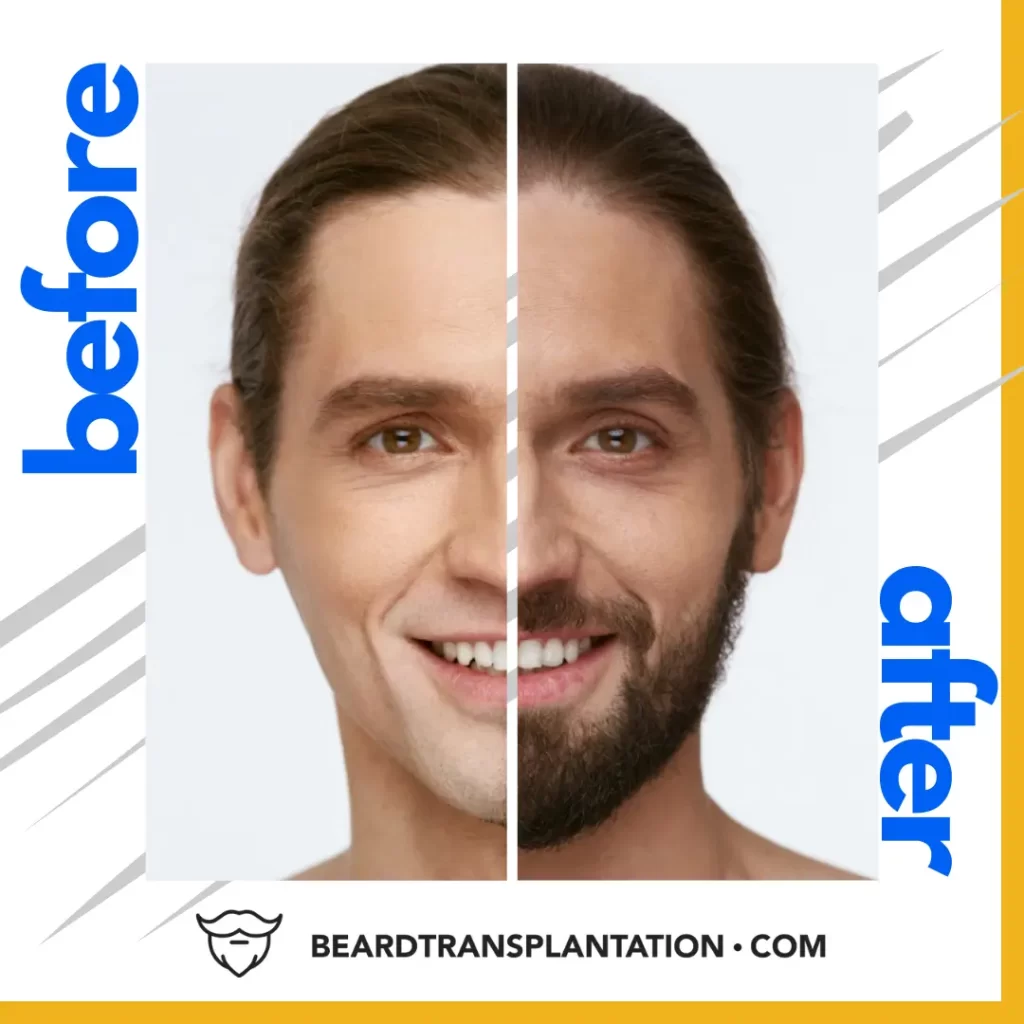Beard Transplant Before and After
Beard Transplantation is a type of cosmetic hair transplant procedure in which follicles are extracted from one part of the body and implanted in the patchy or bald areas of the jawline and moustache region for the sake of enhanced before and after results manifesting as an aesthetic improvement of the jawline region. Check out “beard transplant results” for more on the beard transplant process. This article is dedicated to beard transplant before and after information so stick around to find out more about this specialized, permanent hair restoration for men looking to improve their beard aesthetic.
Talk to a Beard Transplant Specialist
Trouble? Scan this QR code with your phone to open WhatsApp. Your privacy is important to us.
- Get Before / After Catalog
- All-Inclusive Prices
- Free e-book
- Access to webinars
- Special giveaways
- Unique discounts
Table of Contents
Before and after beard restoration in pictures


Beard transplant before and after results using different transplant methods
The 3 most common methods of beard transplantation include Follicular Unit Transfer (FUT), Follicular Unit Extraction (FUE) and Direct Hair Implant (DHI). We’re breaking down the pros and cons of each method and what before and after beard transplant results may come of using each method:
FUT
FUT is amongst the first methods of hair transplantation to be used and can be defined as the extraction of a strip of skin from the donor area from which hair follicles are then extracted and implanted into miniature incisions in the recipient area. The donor wound edges are then closed with micro stitches or staples.
The pros of FUT | The cons of FUT |
Reduced procedure duration. | Visible linear scarring. |
A higher number of grafts transferred per session. | Longer duration of recovery. |
A cheaper hair restoration solution. | Requires stitches or staples to be removed after approximately 7 days. |

FUE
The more scientifically advanced beard transplant clinics offer progressive methods such as FUE, which consists of the individual extraction of hair grafts from the donor area, behind the heard between the ears or below the chin. The hair grafts are then implanted into micro incisions in specific directions, angles, and depths for a natural-looking, successful beard restoration procedure. This method is most suitable for those struggling with baldness.
The pros of FUE | The cons of FUE |
Shorter recovery time. | Pricier beard transplant method. |
Scarring is virtually invisible. | Extended procedure duration. |
Does not require stitches or staples after implantation. | May require additional surgery if you require an excessive number of grafts. |
Does not require a second visit after a week for the removal of stitches or staples. |
|

DHI
The DHI beard transplant technique is a modification of the FUE method as it involves individual graft extraction. However, the implantation process differs from FUE with extracted grafts being inserted into a device known as a Choi-pen which acts as a punch when inserting the grafts into the problematic recipient zone.
The pros of DHI | The cons of DHI |
Shorter recovery time. | Pricier beard transplant method. |
Scarring is virtually invisible. |
|
Does not require stitches or staples after implantation. |
|
Does not require a second visit after a week for the removal of stitches or staples. |
|
Reduced procedure duration. |
|


Preparation before a beard transplant
Before the day of the procedure, most clinics will advise that you do some preparation of the beard transplant area in order to ensure that both the donor hair and the skin in your recipient area is healthy. Here are some guidelines for prepping before beard transplantation which may just help boost your ultimate beard hair restoration results and limit your risk of any complications.
Take hair vitamins
If you do not already do so, it is recommended that you take hair growth-boosting and skin health-boosting vitamins.
It’s best to opt for hair vitamins that include vitamin B complex and vitamin D which have been proven to stimulate hair growth, and vitamin C which assists in the absorption of nutrients which in turn contributes to healthier hair and skin.
Grow out your beard hair
Your surgeon needs to implant hair grafts into your beard region in such a way that your newly transplanted beard hair blends seamlessly with the rest of your hair and the final beard transplant before and after results are natural.
By growing out your beard, your surgeon will be able to conduct a proper evaluation of your natural hair growth pattern, ultimately ensuring the most natural result possible. However, growing out donor hair is not necessary and does not pose any advantages.
Avoid blood-thinning medications
To avoid excessive bleeding complications during your beard transplant procedure, it is especially important to avoid medications with blood-thinning properties, this includes all hair vitamins that contain vitamin E.
Such bleeding may result in a prolonged duration of the beard transplant procedure and poor graft survival which could ultimately impact your beard transplant before and after results negatively.
Healthy Lifestyle Habits
By committing to healthier habits before your beard transplantation, you are setting yourself up for a successful recovery process. Such commitments may include improving the quality of the foods you consume.
To do this, you should opt for foods that are rich in essential fatty acids, vitamins and proteins for stronger hair, speedier hair growth and an increased ability to perform normal bodily functions, such as wound healing for example, following your surgery.
Examination of your donor area before beard restoration surgery
Once you have arrived at your beard transplant clinic, the team of experts or surgeons will assess your current beard area, take note of your natural hair growth pattern, and establish the reason for your beard balding or patchiness.
It should be noted that unfortunately, not everyone is the best candidate for beard transplantation, therefore the reason for balding or patchiness is assessed before hair transplantation to avoid disappointment.
Good Candidates for Beard Transplantation
- Men over the age of 24
Because hair growth and development continue after puberty, for some this may continue up to the age of 30. For this reason, it is advised that you do not undergo any form of hair restoration surgery below the age of at least 24 as this may result in balding around the initial transplanted hair which would lead to additional hair transplant procedures being required
- Sufficient Donor Hair
When follicles are extracted, the hair will no longer grow in that specific area as there is no existing follicle remaining. Therefore, it is imperative that you possess sufficient donor hair in order to successfully transfer enough grafts to the jawline or moustache area to meet your expectations without negatively affecting the overall aesthetic of the donor area.
- Thick or curly hair
Although a beard restoration procedure may be carried out using both finer or thicker hair, those with thicker or curly hair tend to achieve better transplant results as the hair density is much greater, providing more coverage before and after beard transplantation.
- Men struggling with the effects of alopecia barbae
Alopecia barbae is a condition described as hair loss exclusively in the beard area. The exact causes of beard hair loss as a result of alopecia barbae are unknown, however, alopecia as a whole is commonly contributed to physical stress, emotional stress and genetics. This type of hair loss results in circular bald patches or total balding. But the good news is that if you struggle with this condition, you may also benefit from the beard transplant before and after results.
Establishing your beard transplant goals
Once you have been found to be a suitable candidate for beard transplantation, your surgeon will establish your beard goals and desired aesthetic. Beard transplantation can be done in the beard, sideburn or moustache region and personalised to meet your personal preferences.
For those men who tend to grow hair on their necks, below the jawline, they may stipulate that they would prefer a more defined jawline. In this case, the donor hair will be extracted from below the neck right below the chin and placed in the balding or patchier regions of the beard.
Your surgeon will also advise you on the best beard shape for your specific face shape, considering the width and height of your face. Men with a rounder face may benefit from a beard transplant that focuses on defining the jawline whereas men with a more oval shape may benefit from increased density on the side of their beards to create the illusion of a thicker beard.
Factors That Affect Beard Transplant Recovery
You will experience your final before and after results approximately one year post hair transplant surgery. However, there are various factors that may increase or reduce this estimated recovery time and the overall success of the beard restoration procedure. Amongst those factors include:
The expertise of the beard transplant surgeon
First and foremost, the expertise of the surgeon conducting your beard restoration procedure will have a role to play in the success of any beard transplant both before and after the procedure. A Beard transplant requires the surgeon to implant grafts in a direction and angle that will provide you with the most natural beard transplant. All while these considerations are made by the surgeon, the depth of the graft inserted into the recipient area will determine the survival of the graft. In other words, whether the newly transplanted follicle will yield any hair growth in the long run or not.
Our partnering clinics listed on beardtransplantation.com are equipped with world-class medical experts in the field of hair transplantation, with in-depth know-how on the ins and outs of beard transplantation, all boasting high beard restoration success rates.
Each individual’s personal hair growth cycle
Your beard hair growth cycle plays a major role in the duration of recovery and can be categorized into 3 different phases – telogen, anagen and catagen hair growth phases, with each of them lasting for different periods of time depending on the individual.
Once the hair is implanted into the recipient zone, the hair will enter a phase of dormancy called the telogen phase. This phase generally lasts around 3 months but may last up to 6 months depending on your natural cycle. The telogen phase can be described as a phase of rest for the transplanted hair in which the club hair, described as a bulb that anchors the transplanted hair in the follicle is fully formed, which is why this phase of the recovery process is usually the most detrimental to the graft survival rate post beard transplant.
The anagen phase kicks in as the telogen phase comes to an end and can be described as the growing phase in which you can expect to see visible before and after progress in hair growth and density following your beard transplantation treatment. During this phase from around, the newly transplanted hair will begin growing at the same rate as the rest of the hair, naturally blending with the natural hair as the months pass up until you observe the ultimate beard transplant before and after results around 1 year after your beard transplant procedure.
The last and final phase of the hair growth cycle, for both transplanted and non-transplanted hair, is the catagen phase which follows the anagen growth phase. This phase lasts for approximately 14 days give or take and consists of the hair follicles shrinking which results in a reduced hair growth rate and detachment of the club hair from the follicle. This phase is then followed by the telogen phase wherein the beard hair growth cycle will start all over.
Sufficient aftercare for boosted beard transplant before and after results
The consistency of aftercare post-beard transplant and the quality of the products used to boost beard hair growth and wound recovery play a significant role in the duration of recovery and maximum hair growth.
Some beard transplant clinics offer specialized transplant-friendly products that have been designed to assist in the healing of both the donor and recipient areas, boost hair growth and hair strength. By ensuring that the correct aftercare regime is in place, you can expect a speedier recovery, boosted hair growth and overall wellbeing as a result of increased nutrients in the body owing to beard transplant recovery products.
Your age when deciding to undergo hair transplantation
As mentioned in the ‘Good candidates for beard transplantation’ section of this article, the success of a beard transplant surgery may be affected by your age in the event that you are not old enough. This is because most men will only see their maximum natural beard growth years after they hit puberty, with some only experiencing maximum hair growth or further thinning in the jawline and moustache area around 30 years of age.
If the procedure is undergone while you are too young for whatever reason, you may experience unsatisfactory results in the long run as your natural hair surrounding the transplant zone may continue to thin over the next few years. This results in insufficient hair density surrounding the transplanted hair and the need for additional transplant sessions.

Side effects of a beard transplant
While the side effects of a beard restoration procedure are few and minimal, it is important that you keep in mind that like any other cosmetic surgery, there are a few risks following the procedure. These include:
- Redness in the transplanted area
- Sensitivity in both the donor area behind the head and the recipient area of the jawline
- Swelling and bruising within the first few days or weeks following the transplant as a result of minor trauma experienced during the procedure
- A temporary shedding of transplanted hair around 2 weeks following the beard transplant
- Negative side effects as a result of adverse reactions to local anaesthetic, these include tingling, bleeding, bruising and discomfort.
The most popular side effect of any beard transplant surgery is the shedding of newly transplanted hair. It should be noted that shedding experienced 1 to 5 weeks following the procedure is temporary and expected following any form of hair transplantation. You should observe regrowth around 3 to 4 months following your beard restoration procedure, once the hair naturally transitions into the anagen phase.
Conclusion
The beard transplant before and after results following each method above are mostly similar. However, as depicted in the graphs above in which we compare the before and after results of various bear transplant methods, it is evident that both the FUE and DHI beard transplant methods post advantages over the FUT method. The FUT method is a suitable method for those struggling with baldness in the beard, moustache, or sideburn regions while the DHI method is most suitable for those who wish to increase density in their beards due to visible patchiness or thinning of the beard.
Some clinics offer a combined technique beard restoration procedure in which both the FUE and DHI methods are used in conjunction to produce the most natural before and after beard transplant transformations. Book a free consultation and get your ultimate beard transformation now!
Frequently Asked Questions
As with any hair transplant, a beard transplant is a permanent hair restoration solution for those struggling with sparseness or baldness in the jawline. The transplanted hair will continue to grow alongside your native hair as normal, so your beard transplant before and after results will remain for years to come. Beard transplantation results touches more on what you can expect following your procedure and the permanence of your results.
Unlike many other cosmetic procedures, hair transplantation as a whole poses little risk and minimal side effects. These side effects may include redness, numbness, temporary in-grown hairs, temporary shedding of transplanted hair, crusting, scabbing and inverse reaction to local anaesthetic. For more information about recovery, check out the results after different beard transplant methods offered by leading clinics.
Patients usually observe maximum beard transplant results anywhere from 8 to 12 months following the procedure. However, new hair growth can be observed anywhere from 3 to 4 months post beard transplant as the hair enters the anagen phase of the hair growth cycle. This cycle is broken down in beard transplant after 1 year.
The exact outcome of your beard transplant is dependent on various factors such as your genetics, stress levels, diseases or conditions and dietary habits which are all outlined in beard transplantation. However, beard transplantation amongst the top-rated clinics listed on beardtransplantation.com has a high success rate with most clinics recording a graft survival rate of 85 to 98,8%.
Once the hair transitions into the anagen phase, the hair growth rate will speed up and begin growing at the same rate as the rest of the beard. The hair density will increase as the month’s pass, resulting in a natural-looking beard. Book a free consultation and receive a free hair report now!
